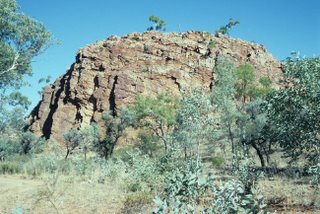I've dug up some figures to demonstrate just how diverse is the snail fauna in the heart of the continent. Check this out.
 Just over 80 species of snails have been recorded from central Australia. That's just in the vicinity of the MacDonnell, Krichauff, James and George Gill Ranges. About a third of those species occur in Finke Gorge. You can hardly stroll around the national park without hearing the sound of snail shells crunching underfoot. (Okay, I made that bit up. They're actually quite difficult to locate. But it's marvellous when you find them. Beer-can-cracking marvellous.)
Just over 80 species of snails have been recorded from central Australia. That's just in the vicinity of the MacDonnell, Krichauff, James and George Gill Ranges. About a third of those species occur in Finke Gorge. You can hardly stroll around the national park without hearing the sound of snail shells crunching underfoot. (Okay, I made that bit up. They're actually quite difficult to locate. But it's marvellous when you find them. Beer-can-cracking marvellous.)Finke Gorge is home to:
- 11 camaenids, seven of which occur nowhere else
- 14 non-camaenids, all of which occur in other locations
This pattern is repeated elsewhere, although the figures vary. At every locality, there's at least one narrow-range endemic camaenid, a handful of more widely distributed camaenids and five or more broad-range non-camaenids. Whatever drives speciation in the camaenids doesn't seem to affect the others.
 There's another interesting snail distribution in the Centre. Bothriembryon spenceri is a bulimulid found in a few sites at Finke Gorge and in nearby ranges. Bothriembryon is a genus with a large number of species in Western Australia. A few extend across the Nullabor Plain into South Australia and one lives in eastern Tasmania. Odd, eh? (Warning: what follows is purely speculation.) It may be that both the camaenids and Bothriembryon are Gondwanan in origin, but the first are descendants of rainforest ancestors and the second of arid-adapted ones. Or I could be barking up the wrong tree entirely.
There's another interesting snail distribution in the Centre. Bothriembryon spenceri is a bulimulid found in a few sites at Finke Gorge and in nearby ranges. Bothriembryon is a genus with a large number of species in Western Australia. A few extend across the Nullabor Plain into South Australia and one lives in eastern Tasmania. Odd, eh? (Warning: what follows is purely speculation.) It may be that both the camaenids and Bothriembryon are Gondwanan in origin, but the first are descendants of rainforest ancestors and the second of arid-adapted ones. Or I could be barking up the wrong tree entirely. And I found the photo of the only known locality of the new species mentioned below. This is it—its entire range. Impressive, ain't it?
And I found the photo of the only known locality of the new species mentioned below. This is it—its entire range. Impressive, ain't it?